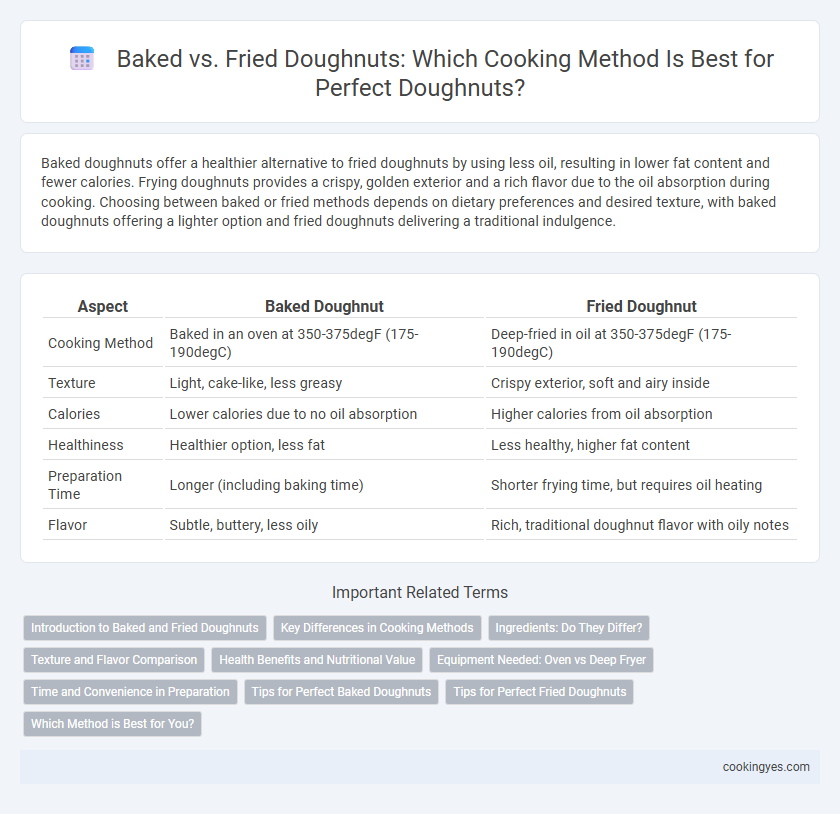Baked doughnuts offer a healthier alternative to fried doughnuts by using less oil, resulting in lower fat content and fewer calories. Frying doughnuts provides a crispy, golden exterior and a rich flavor due to the oil absorption during cooking. Choosing between baked or fried methods depends on dietary preferences and desired texture, with baked doughnuts offering a lighter option and fried doughnuts delivering a traditional indulgence.
Table of Comparison
| Aspect | Baked Doughnut | Fried Doughnut |
|---|---|---|
| Cooking Method | Baked in an oven at 350-375degF (175-190degC) | Deep-fried in oil at 350-375degF (175-190degC) |
| Texture | Light, cake-like, less greasy | Crispy exterior, soft and airy inside |
| Calories | Lower calories due to no oil absorption | Higher calories from oil absorption |
| Healthiness | Healthier option, less fat | Less healthy, higher fat content |
| Preparation Time | Longer (including baking time) | Shorter frying time, but requires oil heating |
| Flavor | Subtle, buttery, less oily | Rich, traditional doughnut flavor with oily notes |
Introduction to Baked and Fried Doughnuts
Baked doughnuts are prepared by cooking the dough in an oven, resulting in a lighter texture with less oil absorption compared to fried doughnuts. Fried doughnuts undergo deep frying in hot oil, creating a crispy exterior and moist interior due to rapid cooking at high temperatures. Both methods influence the doughnut's flavor, texture, and nutritional profile significantly.
Key Differences in Cooking Methods
Baked doughnuts are cooked in an oven using dry heat, resulting in a lighter texture and lower fat content compared to fried doughnuts, which are submerged in hot oil, creating a crispier exterior and richer flavor due to oil absorption. The baking process requires precise temperature control to ensure even rising and a tender crumb, whereas frying demands constant oil temperature monitoring to prevent greasiness and achieve a golden-brown crust. Key differences include cooking time, texture, and nutritional profile, with baked doughnuts generally being healthier but less crispy than their fried counterparts.
Ingredients: Do They Differ?
Baked doughnuts typically contain less oil and often use baking powder or baking soda as leavening agents, resulting in a lighter texture, while fried doughnuts rely on yeast or chemical leaveners combined with deep-frying to achieve a crisp exterior. The ingredient lists for baked doughnuts often include lower fat content and reduced sugar compared to fried varieties, emphasizing healthier alternatives. Both types use similar base ingredients like flour, sugar, eggs, and milk, but the method of cooking influences ingredient proportions and overall nutritional profile.
Texture and Flavor Comparison
Baked doughnuts have a lighter, cakey texture due to the dry heat cooking method, resulting in a less oily and slightly drier bite. Fried doughnuts develop a crisp exterior and a moist, tender interior from the hot oil, creating a rich, indulgent flavor with a slight caramelized note. The frying process enhances flavor complexity through Maillard reactions, while baked doughnuts offer a subtler taste with healthier fat content.
Health Benefits and Nutritional Value
Baked doughnuts contain fewer calories and less fat compared to fried doughnuts due to the absence of oil absorption during cooking. This method preserves more nutrients while reducing unhealthy trans fats, making baked doughnuts a healthier option for weight management and heart health. Nutritionally, baked doughnuts often have lower cholesterol levels and less saturated fat, contributing to improved cardiovascular benefits.
Equipment Needed: Oven vs Deep Fryer
Baked doughnuts require an oven, which provides even heat distribution and a healthier cooking environment by minimizing oil absorption. Fried doughnuts need a deep fryer or a heavy pot filled with hot oil, which produces a crispier exterior and richer flavor due to Maillard reactions. The choice between oven and deep fryer impacts texture, calories, and equipment maintenance.
Time and Convenience in Preparation
Baked doughnuts require less preparation time since they do not need oil heating and careful frying, making the cooking process quicker and safer. Fried doughnuts typically take longer due to the need to maintain hot oil temperature and monitor frying to achieve the perfect golden crust. Baked doughnuts offer greater convenience with simpler cleanup and reduced risk of oil splatters, ideal for efficient home baking.
Tips for Perfect Baked Doughnuts
For perfect baked doughnuts, preheat the oven to 350degF and lightly grease the doughnut pan to prevent sticking. Use a batter that's slightly thicker than cake batter to ensure a moist and tender texture, and avoid overfilling the molds to maintain the doughnut shape. Bake for 10-12 minutes or until a toothpick comes out clean, then allow them to cool slightly before glazing or decorating.
Tips for Perfect Fried Doughnuts
To achieve perfect fried doughnuts, maintain the oil temperature between 350degF and 375degF to ensure a crispy exterior and fully cooked interior without excessive oil absorption. Use fresh, non-hydrogenated shortening or vegetable oil for consistent heat distribution and a clean taste. Drain fried doughnuts on paper towels immediately after frying to remove excess oil, preserving their light texture and flavor.
Which Method is Best for You?
Baked doughnuts offer a healthier alternative by using less oil, resulting in lower fat content and fewer calories compared to fried doughnuts, which are cooked by deep-frying in hot oil for a crispier texture and richer flavor. Choosing baked doughnuts suits those seeking a lighter treat with easier preparation and less mess, while fried doughnuts cater to individuals prioritizing a traditional taste and indulgent mouthfeel. Assessing dietary goals and texture preferences helps determine whether the moisture-retaining, tender baked method or the crunchy, golden fried method is best for you.
Baked Doughnut vs Fried Doughnut for Cooking Method Infographic

 cookingyes.com
cookingyes.com